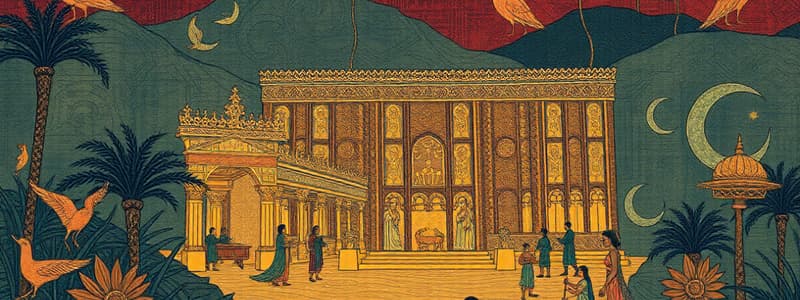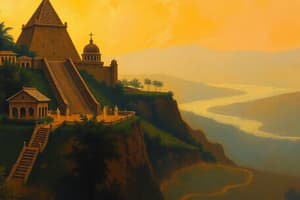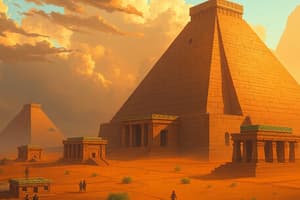Podcast
Questions and Answers
Which factor most significantly hampered deeper historical understanding of sub-Saharan African kingdoms?
Which factor most significantly hampered deeper historical understanding of sub-Saharan African kingdoms?
- Lack of interest from European historians until recently
- Reliance on oral tradition rather than written records (correct)
- Geographic inaccessibility, making archaeological digs impossible
- The intentional destruction of historical records by invading forces
The kingdom of Kush, after being driven out of Egypt by the Assyrians, ceased to exist entirely.
The kingdom of Kush, after being driven out of Egypt by the Assyrians, ceased to exist entirely.
False (B)
What was the primary commodity that drove the wealth of the western African kingdoms of Ghana, Mali and Songhai?
What was the primary commodity that drove the wealth of the western African kingdoms of Ghana, Mali and Songhai?
gold
The conversion of Aksum to Christianity is largely attributed to the work of a Syrian Christian missionary named ______.
The conversion of Aksum to Christianity is largely attributed to the work of a Syrian Christian missionary named ______.
Match the following African kingdoms/locations with their defining characteristics or contributions:
Match the following African kingdoms/locations with their defining characteristics or contributions:
What was the significant impact of Mansa Musa's pilgrimage to Mecca in 1324?
What was the significant impact of Mansa Musa's pilgrimage to Mecca in 1324?
The language of the city-states, Swahili, was more dominantly native African but contained elements of Arabic, Persian, and Indian.
The language of the city-states, Swahili, was more dominantly native African but contained elements of Arabic, Persian, and Indian.
What military advantage did Moroccan forces possess that led to the downfall of the Songhai Empire?
What military advantage did Moroccan forces possess that led to the downfall of the Songhai Empire?
Prior to European contact, the primary external demand for enslaved people in Africa came from ______ regions due to the spread of Islam.
Prior to European contact, the primary external demand for enslaved people in Africa came from ______ regions due to the spread of Islam.
Which of the following is the most accurate description of traditional African religious beliefs?
Which of the following is the most accurate description of traditional African religious beliefs?
The Niger River played a crucial role in the success of East African city-states.
The Niger River played a crucial role in the success of East African city-states.
What was the name of the ancient African kingdom located south of Egypt, with its capital at Meroë?
What was the name of the ancient African kingdom located south of Egypt, with its capital at Meroë?
Robert W. July's book, titled A History of the African People, highlights the fact that the kingdom of ______ defeated the Kushites around AD 330.
Robert W. July's book, titled A History of the African People, highlights the fact that the kingdom of ______ defeated the Kushites around AD 330.
Which of the following is the best example of cultural syncretism in the East African city-states?
Which of the following is the best example of cultural syncretism in the East African city-states?
In addition to being a centre for trade, Benin produced fine statues and relief sculptures in bronze. The metalworking of Benin became one of the highest known artistic accomplishments of early African history.
In addition to being a centre for trade, Benin produced fine statues and relief sculptures in bronze. The metalworking of Benin became one of the highest known artistic accomplishments of early African history.
Flashcards
Africa
Africa
The second largest continent, covering over one-fifth of the earth's land surface.
Sub-Saharan Africa
Sub-Saharan Africa
The portion of Africa south of the Sahara Desert.
Kingdom of Kush
Kingdom of Kush
An ancient kingdom in northeast Africa, originally a province of the Egyptian Empire, that grew in power and even conquered Egypt.
Aksum (Axum)
Aksum (Axum)
Signup and view all the flashcards
Frumentius
Frumentius
Signup and view all the flashcards
Kanem and Bornu
Kanem and Bornu
Signup and view all the flashcards
Ghana, Mali, and Songhai
Ghana, Mali, and Songhai
Signup and view all the flashcards
Mansa Musa
Mansa Musa
Signup and view all the flashcards
East African City-States
East African City-States
Signup and view all the flashcards
Swahili
Swahili
Signup and view all the flashcards
Forest Kingdoms
Forest Kingdoms
Signup and view all the flashcards
Kingdom of Benin
Kingdom of Benin
Signup and view all the flashcards
Polygamy
Polygamy
Signup and view all the flashcards
Tribe
Tribe
Signup and view all the flashcards
Slave Trade
Slave Trade
Signup and view all the flashcards
Study Notes
- Although the Mongols spread over Asia and threatened Europe they never reached Africa
- Africa, the second largest continent, covers over one-fifth of the Earth's land surface and is nearly four times the size of the continental United States
- Despite being a large plateau, Africa has mountains, deserts, grassy flatlands, and jungles
- Egyptians established the earliest recorded civilization in Africa along the Nile
- Carthage thrived in North Africa during the Roman Republic, later becoming part of the Roman Empire
- Muslims spread across North Africa post-Rome's collapse, bringing the region under Islamic control
Sub-Saharan Africa
- Sub-Saharan Africa's history is not as well known but is important
Ancient African Civilizations
- Centuries before Europeans entered sub-Saharan Africa, several African empires and kingdoms thrived
Kingdom of Kush
- The earliest kingdom in northeast Africa was the Kingdom of Kush, located in modern-day northern Sudan
- Kush's capital, Meroë, had ruins near Khartoum
- Originally an Egyptian province, Kush (Nubia) gained power and, by 700 BC, overthrew Egyptian rule and established its dynasty of pharaohs
- The Tirhakah of Ethiopia mentioned in 2 Kings 19:9 is a Kushite ruler, Taharqa
- The Assyrians drove the Kushites out of Egypt in the mid-600s BC, but the Kushite kingdom continued for nearly another thousand years
Kingdom of Aksum
- Kush eventually fell to the kingdom of Aksum
- Around AD 330, the ruler of Aksum defeated the Kushites, burning their towns and destroying statues in their temples
- Aksum embraced Christianity and claimed its rulers were descendants of King Solomon and the Queen of Sheba
Frumentius
- Aksum's conversion to Christianity was likely due to Frumentius, a Syrian Christian
- Aksum's conversion to Christianity intensified trade with the Roman Empire
- Muslim invasions in North Africa later cut off Aksum from European contact
- Aksum continued to exist and became the nucleus of modern Ethiopia
Frumentius, "Apostle to the Abyssinians"
- Frumentius promoted his Christian faith while serving the kingdom
- He encouraged Christian merchants from the Roman Empire to hold private services during their visits to Aksum
- People of Aksum began converting to Christianity under Frumentius
- Ezana, the king who defeated Kush in 330, seemed to accept Christianity later in life, crediting his victory to the "Lord of Heaven"
- Ezana's conversion was perhaps the crowning work of Frumentius, known as the "Apostle to the Abyssinians"
Central and Western Africa
- Important kingdoms arose in central and western Africa during Europe's Middle Ages
- A lot of the histories were not written but orally passed
- Oral tradition, archaeology, and accounts by non-Africans provide insight into these cultures
- The kingdoms of Kanem (ca. 700-1380) and Bornu (1396-1893) thrived on Lake Chad in Central Africa
- These kingdoms profited from camel caravan trade and built strong militaries
- The three kingdoms of western Africa were Ghana, Mali, and Songhai
Ghana, Mali, and Songhai
- Ghana, Mali, and Songhai's wealth derived from gold mines and camel caravan trade in gold, salt, and other precious items across the Sahara
- The Niger River provided a base for these empires as its waters drew travelers crossing the desert
- Ghana rose to prominence first, enjoying its heyday from ca. 700 to 1200
- Muslim forces from northern Africa attacked and weakened Ghana in the eleventh century but failed to conquer it
- Mali rose to power, dominating western Africa from 1200 to 1500
- Mansa Musa (r. 1312-ca. 1337) was the most famous ruler of Mali
- Mansa Musa made a pilgrimage to Mecca in 1324 with sixty thousand men and several thousand pounds of gold and astonished the Egyptians with his wealth while staying in Cairo
- Musa's capital, Timbuktu, became Africa's most important centre of trade
- Books began to rival gold as an item for trade
Songhai Empire
- In the fifteenth century, the Songhai Empire overthrew the Mali Empire
- It stretched farther than either Ghana or Mali, reaching the Atlantic in the west and pressing the kingdom of Bornu on Lake Chad in the east
- Invading Moroccan forces with muzzle-loading guns ended the Songhai Empire in 1591, ending the western African empires
East African City-States
- A series of independent city-states existed along the eastern coast of Africa as early as the Roman Empire
- After the collapse of Rome, they kept flourishing as outlets for gold, iron, ivory, and animal skins to the Arabs and Persians
- Prosperous city-states traded goods from the interior with Arab sea traders
- Kilwa grew wealthy and cultured due to this trade and a temperate climate
- These city-states shared a culture that was a mixture of Arab, Persian, and African elements
- The architecture was predominantly Arab, and the language of the city-states, Swahili, was dominantly native African but contained elements of Arabic, Persian, and Indian
- After 1500, the city-states were conquered by Portuguese forces who attacked the coasts to seize control of trade
- The Swahili language has survived, and the term Swahili is used to describe the culture of some eastern Africans
Forest Kingdoms
- The "forest kingdoms" of the interior of Africa provided goods for the eastern city-states to sell
- Records of these kingdoms are scarce
- The best-known forest kingdoms are those with which Europeans came into contact right after the close of the Middle Ages
- The most important was the kingdom of Benin in western Africa (today's southern Nigeria)
- It arose in 1440 and lasted until 1897 and was a centre for trade
- Benin produced fine statues and relief sculptures in bronze. The metalworking of Benin became one of the highest known artistic accomplishments of early African history
African Culture
- Daily life for most Africans centred on smaller social organisations rather than kingdoms and empires
- The family was foundational
- Polygamy was common in many tribes, families were large and complex
- Several families with a common ancestor formed a clan
- A group of two or more clans, in turn, formed a tribe
- The tribe was perhaps the most important cultural organisation, and a single tribe dominated many African kingdoms
- Some regions embraced Christianity, while Islam claimed many converts who only displayed superficial adherence
- Muslim patterns often influenced African kingdoms in structuring their governments, organising their systems of education, and establishing their currency
- Most people in sub-Saharan Africa held to traditional tribal religions
- These traditional religions taught that there was a high god who created the universe, and below him were lesser gods and the spirits of dead ancestors
- Prayers and sacrifices were offered to these gods to ward off illnesses and increase crop yields
- Most Africans relied on farming or herding to sustain themselves and their families
- Trade, was the stay of the African kingdoms (gold, salt, ivory, and animal skins)
- As Europeans began sailing to African ports, the camel caravan trade became less important
- A new trade opened with Arabs and later with Europeans known as the slave trade
- Demand for slaves increased as Islam became dominant in many regions
- This traffic in human lives became one of the main points of contact for African-European relations after 1500, leading to terrible suffering and exploitation of the African people
Studying That Suits You
Use AI to generate personalized quizzes and flashcards to suit your learning preferences.




